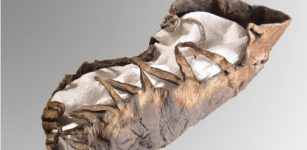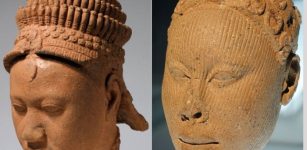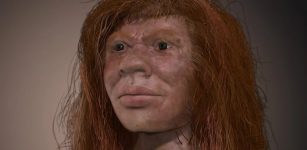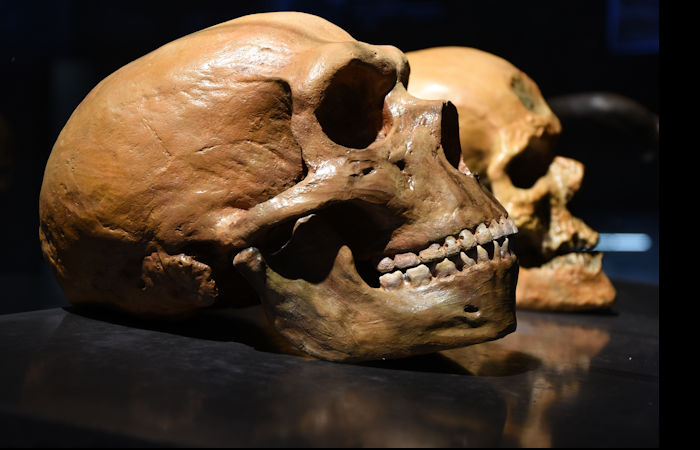Human And Neanderthal Brains Have A Surprising ‘Youthful’ Quality In Common – New Study
AncientPages.com - Many believe our particularly large brain is what makes us human – but is there more to it? The brain’s shape, as well as the shapes of its component parts (lobes) may also be important.
Neanderthal vs human skull. Credit: Adobe Stock - Bruder
Results of a study we published in Nature Ecology & Evolution show that the way the different parts of the human brain evolved separates us from our primate relatives. In a sense, our brains never grow up. We share this “Peter Pan syndrome” with only one other primate – the Neanderthals.
Our findings provide insight into what makes us human, but also further narrow any distinction between ourselves and our extinct, heavy-browed cousins.
Tracking the evolution of the brain
Mammalian brains have four distinct regions or lobes, each with particular functions. The frontal lobe is associated with reasoning and abstract thought, the temporal lobe with preserving memory, the occipital lobe with vision, and the parietal lobe helps to integrate sensory inputs.
The four main parts of the brain form the cerebral cortex. The Conversation, CC BY-ND
We investigated whether the brain’s lobes evolved independently of each other, or whether evolutionary change in any one lobe appears to be necessarily tied to changes in others – that is, evidence the evolution of the lobes is “integrated”.
In particular, we wanted to know how human brains might differ from other primates in this respect.
One way to address this question is to look at how the different lobes have changed over time among different species, measuring how much shape change in each lobe correlates with shape change in others.
Alternatively, we can measure the degree to which the brain’s lobes are integrated with each other as an animal grows through different stages of its life cycle.
Does a shape change in one part of the growing brain correlate with change in other parts? This can be informative because evolutionary steps can often be retraced through an animal’s development. A common example is the brief appearance of gill slits in early human embryos, reflecting the fact we can trace our evolution back to fish.
We used both methods. Our first analysis included 3D brain models of hundreds of living and fossil primates (monkeys and apes, as well as humans and our close fossil relatives). This allowed us to map brain evolution over time.
Our other digital brain data set consisted of living ape species and humans at different growth stages, allowing us to chart integration of the brain’s parts in different species as they mature. Our brain models were based on CT scans of skulls. By digitally filling the brain cavities, you can get a good approximation of the brain’s shape.
A surprising result
The results of our analyses surprised us. Tracking change over deep time across dozens of primate species, we found humans had particularly high levels of brain integration, especially between the parietal and frontal lobes.
But we also found we’re not unique. Integration between these lobes was similarly high in Neanderthals too.
Looking at changes in shape through growth revealed that in apes, such as the chimpanzee, integration between the brain’s lobes is comparable to that of humans until they reach adolescence.
At this point, integration rapidly falls away in the apes, but continues well into adulthood in humans.
Left: a chart shows the degree of integration between the brain’s lobes, with cooler colours indicating higher integration. Right: translucent skulls of a human, Neanderthal, chimp and gorilla, showing the digitally reconstructed brains within. Gabriele Sansalone and Marina Melchionna, Author provided
Neanderthals were sophisticated people
So what does this all mean? Our result suggest what distinguishes us from other primates is not just that our brains are bigger. The evolution of the different parts of our brain is more deeply integrated, and, unlike any other living primate, we retain this right through into adult life.
A greater capacity for learning is typically associated with juvenile life stages. We suggest this Peter Pan syndrome played a powerful role in the evolution of human intelligence.
There’s another important implication. It’s increasingly clear that Neanderthals, long characterised as brutish dullards, were adaptable, capable and sophisticated people.
Archaeological findings continue to mount support for their development of sophisticated technologies, from the earliest known evidence of string, to the manufacture of tar. Neanderthal cave art shows they indulged in complex symbolic thought.
Us and them
Our results further blur any dividing line between us and them. This said, many remain convinced some innately superior intellectual quality gave us humans a competitive advantage, allowing us to drive our “inferior” cousins to extinction.
There are many reasons why one group of people may dominate, or even eradicate others. Early Western scientists sought to identify cranial features linked to their own “greater intelligence” to explain world domination by Europeans. Of course, we now know skull shape had nothing to do with it.
We humans may ourselves have come perilously close to extinction 70,000 years ago.
If so, it’s not because we weren’t smart. If we had gone extinct, perhaps the descendants of Neanderthals would today be scratching their heads, trying to figure out just how their “superior” brains gave them the edge.
Provided by The Conversation
This article is republished from The Conversation under a Creative Commons license. Read the original article.
More From Ancient Pages
-
 Archaeologists Uncover More Hidden Ancient Secrets In Saqqara, Egypt
Archaeology | Jan 6, 2025
Archaeologists Uncover More Hidden Ancient Secrets In Saqqara, Egypt
Archaeology | Jan 6, 2025 -
 900-Year-Old Crypt At Old Dongola: Magical Inscriptions And Mysterious Signs Found
Archaeology | Sep 12, 2015
900-Year-Old Crypt At Old Dongola: Magical Inscriptions And Mysterious Signs Found
Archaeology | Sep 12, 2015 -
 Painted Tikal Altar Unlocks The Ancient Secrets Of A Mysterious Maya Period
Archaeology | Apr 9, 2025
Painted Tikal Altar Unlocks The Ancient Secrets Of A Mysterious Maya Period
Archaeology | Apr 9, 2025 -
 Was Aztec And Mixtec Turquoise Mined In the American Southwest?
Archaeology | Jun 15, 2018
Was Aztec And Mixtec Turquoise Mined In the American Southwest?
Archaeology | Jun 15, 2018 -
 Long-Lost Wreck Of Crusader Ship And Gold Coins Discovered
Archaeology | Mar 14, 2017
Long-Lost Wreck Of Crusader Ship And Gold Coins Discovered
Archaeology | Mar 14, 2017 -
 Revealing 1,200 Years Of Arctic Canadian Cultures And Settlements In Canada
Archaeology | Jul 11, 2024
Revealing 1,200 Years Of Arctic Canadian Cultures And Settlements In Canada
Archaeology | Jul 11, 2024 -
 Extremely Well Preserved 2,000-Year-Old Child Shoe Discovered In Salt Mine
Archaeology | Sep 5, 2023
Extremely Well Preserved 2,000-Year-Old Child Shoe Discovered In Salt Mine
Archaeology | Sep 5, 2023 -
 Horned Serpent – Unusual Ancient Creature Encountered Worldwide – Can Archaeological Finds Confirm Thousand-Year-Old Myths Again?
Ancient Mysteries | Apr 15, 2025
Horned Serpent – Unusual Ancient Creature Encountered Worldwide – Can Archaeological Finds Confirm Thousand-Year-Old Myths Again?
Ancient Mysteries | Apr 15, 2025 -
 Incredible Sedlec Ossuary – Church Of Bones Reveals More Gruesome Secrets
Archaeology | Dec 4, 2019
Incredible Sedlec Ossuary – Church Of Bones Reveals More Gruesome Secrets
Archaeology | Dec 4, 2019 -
 Ife Head: Significance Of The Head ‘Ori’ In Yoruba Ancient And Present Beliefs
Artifacts | Mar 27, 2019
Ife Head: Significance Of The Head ‘Ori’ In Yoruba Ancient And Present Beliefs
Artifacts | Mar 27, 2019 -
 Mystery Of The Stull Cemetery: A Gateway To Hell?
Featured Stories | Aug 25, 2018
Mystery Of The Stull Cemetery: A Gateway To Hell?
Featured Stories | Aug 25, 2018 -
 Historic Shipwreck Mentor Reveals Its Underwater Secrets
Archaeology | May 14, 2022
Historic Shipwreck Mentor Reveals Its Underwater Secrets
Archaeology | May 14, 2022 -
 Mysteries Of The Old Kingdom – Unknown Rock-Cut Tombs With False Doors And Artifacts Unearthed In Aswan’s Qubbet El-Hawa Necropolis
Archaeology | Jun 30, 2025
Mysteries Of The Old Kingdom – Unknown Rock-Cut Tombs With False Doors And Artifacts Unearthed In Aswan’s Qubbet El-Hawa Necropolis
Archaeology | Jun 30, 2025 -
 Prehistoric Puzzle: Three Gigantic Stone Heads Of Unknown Origin
Featured Stories | Mar 17, 2020
Prehistoric Puzzle: Three Gigantic Stone Heads Of Unknown Origin
Featured Stories | Mar 17, 2020 -
 Attempt To Smuggle Three Artefacts From Alexandria Port – Failed
Artifacts | Oct 28, 2020
Attempt To Smuggle Three Artefacts From Alexandria Port – Failed
Artifacts | Oct 28, 2020 -
 Unique Sword Discovered In Mysterious Pre-Viking Tomb In Uppsala, Sweden
Archaeology | Sep 2, 2019
Unique Sword Discovered In Mysterious Pre-Viking Tomb In Uppsala, Sweden
Archaeology | Sep 2, 2019 -
 Jedek: Previously Unidentified Language Found By Swedish Linguists In in Southeast Asia
Linguistic Discoveries | Feb 9, 2018
Jedek: Previously Unidentified Language Found By Swedish Linguists In in Southeast Asia
Linguistic Discoveries | Feb 9, 2018 -
 Who Is Buried In The Giant Etruscan Tomb At San Giuliano Necropolis?
Archaeology | Mar 13, 2024
Who Is Buried In The Giant Etruscan Tomb At San Giuliano Necropolis?
Archaeology | Mar 13, 2024 -
 Mysterious Denny – 90,000-Year-Old Child Whose Parents Were Two Different Human Species
Featured Stories | Jul 25, 2023
Mysterious Denny – 90,000-Year-Old Child Whose Parents Were Two Different Human Species
Featured Stories | Jul 25, 2023 -
 Balkanatolia: Existence Of A Long-Forgotten Continent Discovered
Archaeology | Mar 1, 2022
Balkanatolia: Existence Of A Long-Forgotten Continent Discovered
Archaeology | Mar 1, 2022



